Related Research Articles
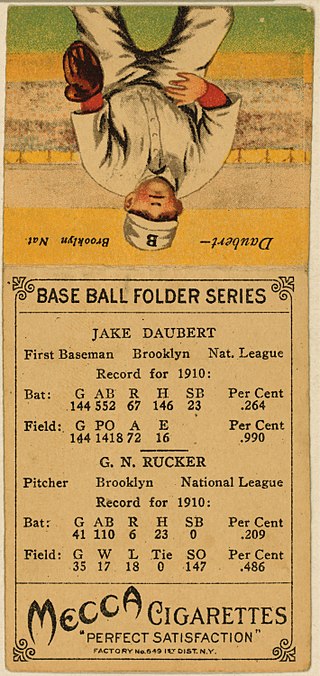
Baseball statistics include a variety of metrics used to evaluate player and team performance in the sport of baseball.
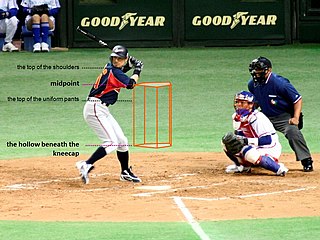
A base on balls (BB), better known as a walk, occurs in baseball when a batter receives four pitches during a plate appearance that the umpire calls balls, and is in turn awarded first base without the possibility of being called out. The base on balls is defined in Section 2.00 of baseball's Official Rules, and further detail is given in 6.08(a). Despite being known as a "walk", it is considered a faux pas for a professional player to actually walk to first base; the batter-runner and any advancing runners normally jog on such a play.

In baseball statistics, a hit, also called a base hit, is credited to a batter when the batter safely reaches or passes first base after hitting the ball into fair territory with neither the benefit of an error nor a fielder's choice.
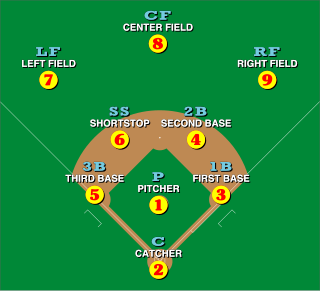
In the sport of baseball, each of the nine players on a team is assigned a particular fielding position when it is their turn to play defense. Each position conventionally has an associated number, for use in scorekeeping by the official scorer: 1 (pitcher), 2 (catcher), 3, 4, 5, 6 (shortstop), 7, 8, and 9. Collectively, these positions are usually grouped into three groups: the outfield, the infield, and the battery. Traditionally, players within each group will often be more able to exchange positions easily ; however, the pitcher and catcher are highly specialized positions and rarely will play at other positions.

In baseball, a home run, homerun or homer is scored when the ball is hit in such a way that the batter is able to circle the bases and reach home plate safely in one play without any errors being committed by the defensive team. A home run is usually achieved by hitting the ball over the outfield fence between the foul poles without the ball touching the field.

Rounders is a bat-and-ball game played between two teams. Rounders is a striking and fielding team game that involves hitting a small, hard, leather-cased ball with a wooden, plastic, or metal bat that has a rounded end. The players score by running around the four bases on the field.

Softball is a popular variation of baseball, the difference being that it is played with a larger ball, on a smaller field, and with only underhand pitches permitted. Softball is played competitively at club levels, the college level, and the professional level. The game was first created in 1887 in Chicago by George Hancock.
In baseball, fielder's choice refers to a variety of plays involving an offensive player reaching a base due to the defense's attempt to put out another baserunner, or the defensive team's indifference to his advance. Fielder's choice is not called by the umpires on the field of play; rather, it is recorded by the official scorer to account for the offensive player's advance without crediting him with an offensive statistic such as a hit or stolen base.
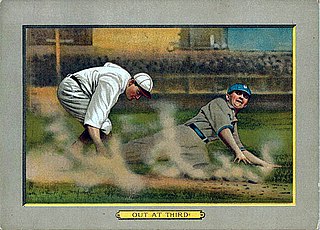
In baseball, an out occurs when the umpire rules a batter or baserunner out. When a batter or runner is out, they lose their ability to score a run and must return to the dugout until their next turn at bat. When three outs are recorded in a half-inning, the batting team's turn expires.

Throughout baseball's history, the rules have frequently changed as the game continues to evolve. A few typical rules most professional leagues have in common are that four balls are a base on balls, three strikes are a strikeout, and three outs end a half-inning.
In baseball, interference occurs in situations in which a person illegally changes the course of play from what is expected. Interference might be committed by players on the offense, players not currently in the game, catchers, umpires, or spectators. Each type of interference is covered differently by the rules.

Pesäpallo is a fast-moving bat-and-ball sport that is often referred to as the national sport of Finland and has some presence in other places including Germany, Sweden, Switzerland, Australia, and Canada's northern Ontario. It is similar to brännboll, rounders, lapta, and baseball.

Brännboll, known as rundbold in Denmark, Brennball in Germany, and sharing the names slåball and brentball with longball in Norway, is a bat-and-ball game similar to longball, played at amateur level throughout Sweden, Finland, Norway, Denmark and Germany. The game is mostly played on fields, sports grounds, and in public parks, but it is also part of the PE curriculum in some areas. The name is derived from the act of catching a player between two bases at the end of a batting round, referred to as "burning" them (bränna), roughly equivalent to being run out in cricket or out in baseball. The world championship, called Brännbollscupen, is an annual event in the Swedish city of Umeå.
In sports, offense or offence, known as attack outside of North America, is the action of attacking or engaging an opposing team with the objective of scoring points or goals. The term may refer to the tactics involved in offense, or a sub-team whose primary responsibility is offense.
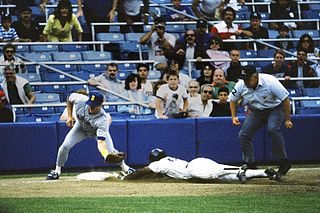
In the sport of baseball, small ball is an informal term for an offensive strategy in which the batting team emphasizes placing runners on base and then advancing them into scoring position for a run in a deliberate, methodical way. This strategy places a high value on individual runs and attempts to score them without requiring extra base hits, or sometimes without base hits at all, instead using bases on balls, stolen bases, sacrifice bunt or sacrifice fly balls, the hit-and-run play, and aggressive baserunning with such plays as the contact play. A commonly used term for a run produced playing small ball is a "manufactured run". This style of play was more often found in National League game situations than in the American League due in large part to the absence of the designated hitter in the National League until the universal adoption of the Designated Hitter.
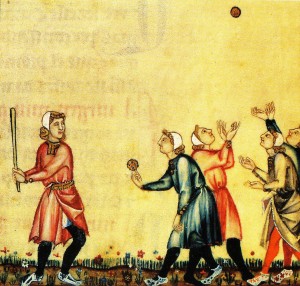
Bat-and-ball games, or safe haven games, are field games played by two opposing teams. Action starts when the defending team throws a ball at a dedicated player of the attacking team, who tries to hit it with a bat and then run between various safe areas in the field to score runs (points). The defending team can use the ball in various ways against the attacking team's players to force them off the field when they are not in safe zones, and thus prevent them from further scoring. The best known modern bat-and-ball games are cricket and baseball, with common roots in the 18th-century games played in England.
This is an alphabetical list of selected unofficial and specialized terms, phrases, and other jargon used in baseball, along with their definitions, including illustrative examples for many entries.

Baseball is a drinking game in which players shoot a ping-pong ball across a table with the intent of landing the ball in one of several cups of beer on the other end, doing so in a way combining beer pong and flip cup. The game typically consists of two teams of even numbers, one on each side of a table, and four cups set up on each side. The cups are lined up in a straight line representing the bases with the last cup at the edge of the table.
Boulevardier from the Bronx is a 1936 Warner Bros. Merrie Melodies cartoon directed by Friz Freleng and released on October 10.
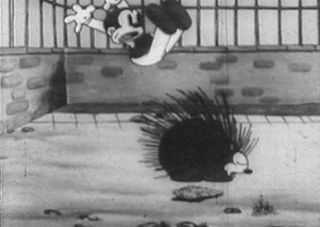
Bosko at the Zoo is an American animated short film featuring Bosko and Honey. It is a Looney Tunes cartoon, released on January 9, 1932. Like most Looney Tunes of the time, it was directed by Hugh Harman. Frank Marsales was its musical director.
References
- ↑ Lenburg, Jeff (1999). The Encyclopedia of Animated Cartoons. Checkmark Books. p. 97. ISBN 0-8160-3831-7 . Retrieved 6 June 2020.